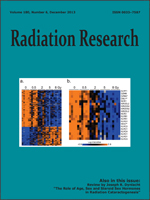Analysis of gamma-H2AX foci in blood lymphocytes is a promising approach for rapid dose estimation to support patient triage after a radiation accident but has one major drawback: the rapid decline of foci levels post-exposure cause major uncertainties in situations where the exact timing between exposure and blood sampling is unknown. To address this issue, radiation-induced apoptosis (RIA) in lymphocytes was investigated using fluorogenic inhibitors of caspases (FLICA) as an independent biomarker for radiation exposure, which may complement the gamma-H2AX assay. Ex vivo X-irradiated peripheral blood lymphocytes from 17 volunteers showed dose- and time-dependent increases in radiation-induced apoptosis over the first 3 days after exposure, albeit with considerable interindividual variation. Comparison with gamma-H2AX and 53BP1 foci counts suggested an inverse correlation between numbers of residual foci and radiation-induced apoptosis in lymphocytes at 24 h postirradiation (P = 0.007). In T-helper (CD4), T-cytotoxic (CD8) and B-cells (CD19), some significant differences in radiation induced DSBs or apoptosis were observed, however no correlation between foci and apoptosis in lymphocyte subsets was observed at 24 h postirradiation. While gamma-H2AX and 53BP1 foci were rapidly induced and then repaired after exposure, radiation-induced apoptosis did not become apparent until 24 h after exposure. Data from six volunteers with different ex vivo doses and post-exposure times were used to test the capability of the combined assay. Results show that simultaneous analysis of gamma-H2AX and radiation-induced apoptosis may provide a rapid and more accurate triage tool in situations where the delay between exposure and blood sampling is unknown compared to gamma-H2AX alone. This combined approach may improve the accuracy of dose estimations in cases where blood sampling is performed days after the radiation exposure.
How to translate text using browser tools
12 November 2013
Combined Analysis of Gamma-H2AX/53BP1 Foci and Caspase Activation in Lymphocyte Subsets Detects Recent and More Remote Radiation Exposures
Simon Horn,
Stephen Barnard,
Darren Brady,
Kevin M. Prise,
Kai Rothkamm
ACCESS THE FULL ARTICLE

Radiation Research
Vol. 180 • No. 6
December 2013
Vol. 180 • No. 6
December 2013




